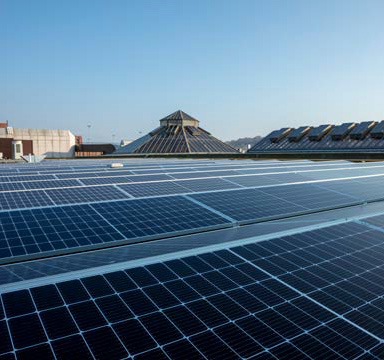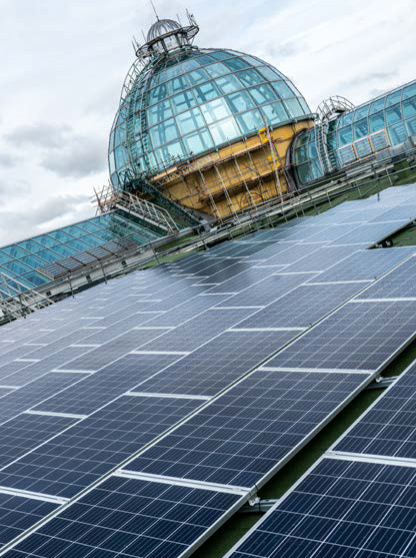Even if we increase our national generation of clean energy, it takes time to get them online (e.g. nuclear), or its distribution and storage (e.g. wind and solar).

Energy sourcing and production – opportunity or trilemma?
Energy sourcing and production – opportunity or trilemma?
WHAT ARE THE KEY CONSIDERATIONS FOR RETAIL LANDLORDS SEEKING TO IMPROVE THE GREEN CREDENTIALS OF THEIR ENERGY SUPPLIES?
SHOULD LANDLORDS GENERATE ENERGY?
Out of approximately 26.5 million buildings in England and Wales, there are only 1.5 million commercial and industrial properties. Yet, these are responsible for around one third of UK buildings emissions. According to the CCC, after offices retail is the largest non-domestic energy user within the sector. More and more retail landlords are looking to clean up their energy usage, either through operational efficiency improvements, sourcing more sustainable electricity, or producing their own renewable energy.
The 2022 cost of living crisis, associated energy prices and war in Ukraine have brought security of supply rapidly into focus; perhaps no more than for the retail property market, whose fortunes are entwined with that of shoppers. Consumers are impacted by energy costs both through their home bills, but also through onward purchase of goods; with one supermarket chain stating that their
energy bills have gone up 400% in 2022 and passing at least some of this cost onto their customers is unavoidable. Retailer and landlords are therefore increasingly focusing on aligning with renewable energy, both in terms of sourcing and in generating clean energy. While it often isn’t as easy as it sounds, there’s a great opportunity for the retail property sector if projects are undertaken in a careful and considered way.

Image Source: Sovereign Centros
A 2021 study by Ernst & Young found that 76% of consumers would rather buy and use sustainable energy generated in their own community. If everyone wants green energy, but a third of our energy production remains tied to fossil fuels, there’s a clear lag between our national targets for green energy and the insatiable demand for it from businesses and consumers. There simply isn’t enough of it, particularly during the parts of the day when there is most demand.
The government has targeted 100% low carbon energy supply by 2035 and, while we can debate the likelihood of reaching this objective, we can all agree that we’ll see a step change in the development of renewables over the coming decade.
In most cases, the mainstay stopper is the ability to connect into large enough infrastructure to be able to distribute the renewable generation. National Grid and the Distribution Network Operators need to make considerable physical changes to their networks to accommodate. This means the requirement for new land for new equipment, time to upgrade overhead lines etc. In Scotland, where a huge amount of wind generation is settled, they are having to pay producers to stop generating as there is not enough demand in these areas to accommodate it. Undersea cables are beginning to take many gigawatts (GW) of renewable generation south of the border
Two of the biggest considerations for energy use and supply from retail landlords is through photo-voltaic (PV) production and provision of electric charging (EV) charging points.

Image source: Meadowhall Roof Solar Panels
RETAIL’S PLACE FOR PV
Given the lag in supply and demand it’s understandable why more and more landlords are now considering generating their own energy as it plays well with ESG, consumers, and energy bills. The potential for solar generation on retail is huge, but needs to be carefully considered. A strategic assessment of a building’s efficiency, load profile, and growth needs to be taken into account. As well as the likelihood of limiting export to the grid in areas of Distribution Networks which may be struggling.
With one panel needing just under 2m2 of roof space it’s a very flexible solution and suitable in small configurations as well as large; Meadowhall’s array is the size of 88 tennis courts. New technology is also enabling more installations, such as integrated solar tiles that reduce roof load.
In theory, the 650 million sqft of retail & leisure parks, shopping centres, outlet malls, and supermarkets in the UK could accommodate almost 26 million solar panels (at 50% coverage) with a total system size of around 6.5GW (equivalent to two times the 3.2GW capacity of Hinkley C nuclear power station). The Solar Energy UK 2030 target for solar is 40GW by 2030, of which 7GW is expected from commercial buildings, with 2GW already online. In effect, the potential to deliver on solar via commercial property exceeds the current targets from retail alone—and that’s before looking at industrial or office properties.
In practice for a myriad of reasons, this volume of retail space won’t work for wholesale PV installation. Schemes need to be fit for purpose rightsizing to application, calculated and not gestural. A common mistake is adding renewables onto a building for planning with limited design to suit what the building actually uses, can support, or from grid capacity. An estimated 5-10GW of wind farms are pipelined to come online in the next few years, but the infrastructure isn’t there to bring it to our homes and businesses. The same issues will apply to large scale PV installations.

MEETING THE NEED FOR EV
With the plan to phase out diesel vehicles by the end of the decade, the growth required in the EV market is staggering. At the end of April 2022 there were more than 470,000 batteryelectric cars in the UK; they now account for 15% of new registrations. However, this remains below 2% of all passenger cars on the road. It’s estimated that there will be more than 6.5 million pure electric vehicles on UK roads by 2030.
Aside from the scale required in manufacturing, which is having its own supply chain crisis following the global pandemic and the Ukraine war, there are significant issues with the infrastructure required to charge EVs. The UK government has set a target to increase tenfold the number of public chargers to 300,000 by 2030 after criticism that the rollout of public infrastructure is too slow to match rapid growth in sales.
By the best will in the world, the government won’t be able to deliver this unprecedented growth without private sector intervention that will have to have a significant role in delivery, particularly as land ownership will play an integral part. Given
“EV is yet another demand for electricity and PV has the potential to export excess electricity to grid. Both technologies will require reinforcing almost the entirety of the UK network.”
that even with fast charging it takes time for consumers to fuel their EVs, there will be a close relationship with working and shopping environments in making charging as seamless a process as possible; particularly for UK households that don’t have their own off street parking and private charging facility.
Dwell time is one of the key considerations to undertake when scoping the opportunity for sizing of EVs, in both kw and number of spaces. Retail provides a prime opportunity as people do tend to spend longer periods and can shop, eat, or drink while waiting. Shopping centre, retail park owners, and drivethru operators are therefore seeing this as a key opportunity. In theory, if every 5,000 sqft of retail parks, shopping centres and supermarkets had an EV charger, this could provide 20% of the government’s 2030 charger target.
However, a considerable amount of stress will be placed on the grid to provide more demand for EV. This is a physical constraint which, again, creates the need for Distribution Network Operators (DNOs) to upgrade cables, transformers, substations etc. to be able to cater for the extra demand. Unfortunately, it isn’t as simple as just installing a row of chargers as there are issues around grid capacity and whether the local infrastructure can cope with increased demands. Reports abound of frustrated EV owners getting ‘range anxiety’ or finding that fast chargers do not deliver on their promise of quick turnarounds because the installers negated to sufficiently assess local constraints.
In effect, the limit to whether that’s actually deliverable is probably down more to government and DNO investment than the retail landlords themselves.
There’s a big difference geographically in the charging facilities installed to date. London has three times the chargers by head of population than Wales and six times that of Northern Ireland. Rural areas are particularly underserved. There is also a distinct negative correlation between low affluent local authorities and availability of EV charging. With everyone trying to increase charging facilities there is a risk that a lack of coordination will see an oversupply in some locations, under supply in others and the promise of fast charging being unrealised.
THE ENERGY HIERARCHY AND TRILEMMA
In principle, adapting lots of sites to produce or provide vast amounts of energy sounds like an excellent solution to meeting the growing need for cleaner energy. However, there are some key issues that need to be considered that can reduce practicality and increase cost if full due diligence is not undertaken.
EV is after all yet another demand for electricity. PV has the potential to export excess electricity to grid. Both technologies will require reinforcing almost the entirety of the UK network.
The Energy Hierarchy is a classification of energy options, prioritised to assist progress towards a more sustainable energy system. The energy hierarchy doesn’t discount the importance of renewable energy, but puts more focus on the ‘lead in’ to using renewables. It follows the strategy that we should all undertake when assessing our needs; principally following the need to understand your energy through measurement, efficiency, and management before looking to actually implement renewable measures.
To put this another way, seeking more renewable energy sourcing or production are themselves meaningless objectives if not part of a wider strategy to optimise energy efficiency. Bang for buck, energy efficiency is of much more significance that energy delivery. The Carbon Trust suggest that for retailers a 20% cut in energy costs can represent the same bottom-line benefit as a 5% increase in sales.
According to the World Energy Council, the energy trilemma is finding the balance between security of supply, affordability, and sustainability. The UK performs relatively well in terms of energy security, but less so on sustainability; and barely registers on affordability. There’s a misalignment in meeting the objectives of producing clean and cheap energy as the infrastructure is often too antiquated to meet rapidly evolving needs and technologies.
“A 20% cut in energy costs can represent the same bottom-line benefit as a 5% increase in sales.”
The Carbon Trust
Furthermore, we haven’t quite resolved the issue of energy availability and point of production. Too often, we have renewables when we don’t need them; A gap between daytime pricing and night time is increasing under energy trilemma, for example Octopus Go’s night time tariff is a quarter of its daytime tariff. Battery technology is coming online at scale and will be a game changer, as could bidirectional charging of EVs whereby the vehicle parked on people’s drives can act as a battery for devices used in the house. A new development currently under construction in Wales will pair a 22MW battery with a 228MW windfarm to provide enhanced frequency response services for the National Grid.
However, while energy solutions are rarely straightforward to implement, they remain an important way for landlords to address their own energy usage and supply. The retail industry has scale and, therefore, represents a vast opportunity for meeting a large proportion of a landlord’s energy need; the needs of their customers; meeting the government climate change targets; or the more pressing net zero targets that many private sector organisations have set. The journey to Net Zero will not be an easy one but those organisations that collect good energy data, while taking a whole system approach that considers energy efficiency before renewables, will be best placed to deliver positive change to the retail sector.
RETAIL PROPERTY COULD PROVIDE
2.6 MILLION
SOLAR PANELS
PRODUCING
6.5GW
ENERGY EQUIVALENT
TO 2X HINKLEY C
NUCLEAR REACTOR
20% OF UK PUBLIC
EV CHARGERS

